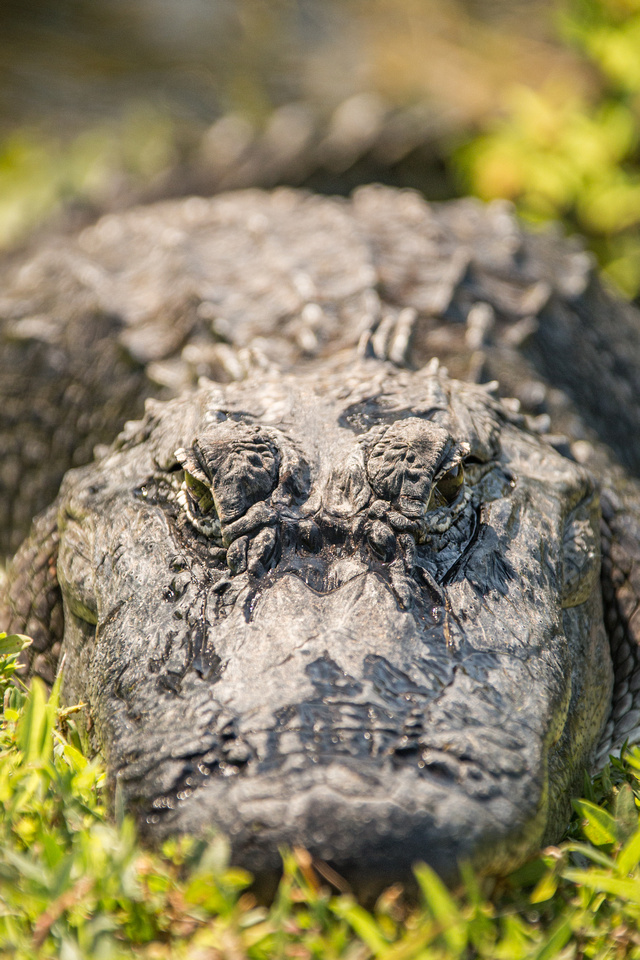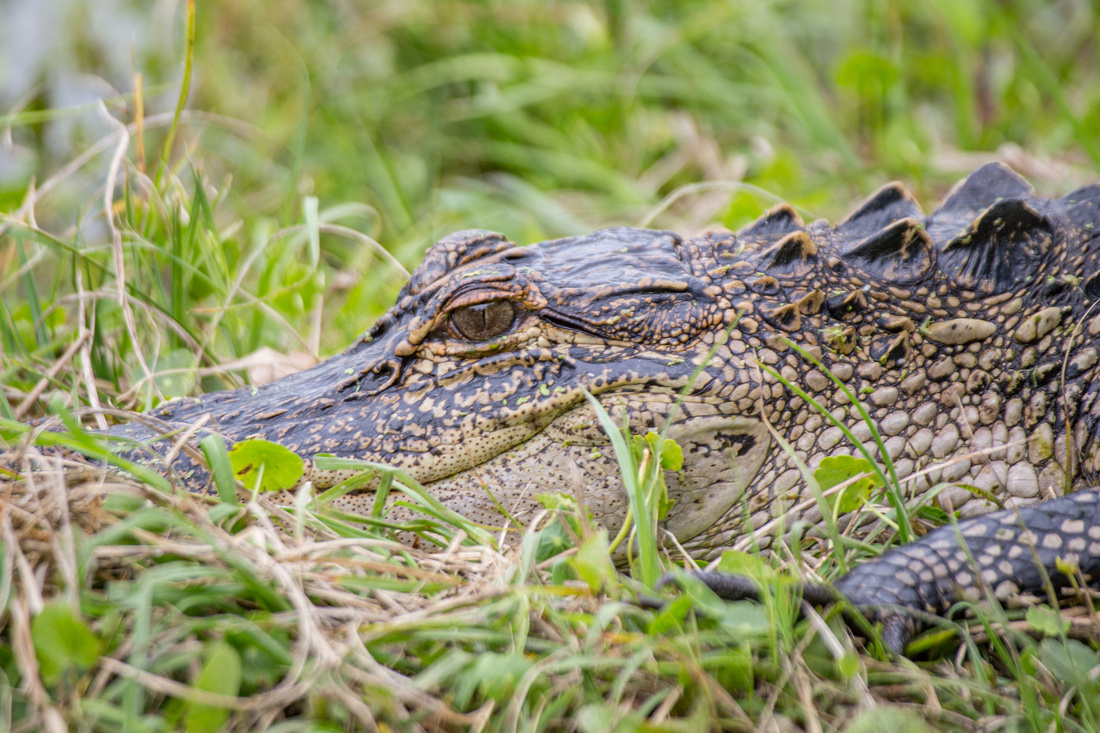Species Highlight: American Alligator
Species Highlight: American Alligator
Text and photos by Heather Cline
The American alligator is the largest reptile in North America. The alligator has many shared characteristics with their ancestors: the dinosaurs. In addition to both being reptiles, they are both cold-blooded, egg-laying, and have a similar skull shape. So, if you would like a view into 66 million years ago, this article on the American Alligator is for you!
Size [Length/Mass]
- Adult male: 9.8 – 15 ft / 500 lbs
- Adult female: 8.5 ft / 200 lbs

 Fun Fact: The largest reported alligator was a male killed in 1890 on Marsh Island, Louisiana, and reportedly measured at 19 ft 2 in.
Fun Fact: The largest reported alligator was a male killed in 1890 on Marsh Island, Louisiana, and reportedly measured at 19 ft 2 in.
Lifespan
30-50 years


Fun Fact: The oldest known alligator is name Muja, and resides at the Belgrade Zoo in Serbia. He was brought to the zoo in August 1937 and was estimated to be 10-12 years old at that time, which would put him over 95 years old today.
Anatomy
- Body temperature: Alligators are ectothermic (cold blooded). They regulate their body temperature by basking in the sun or moving to areas with warmer or cooler air or water temperatures. They are most active when temperatures are between 82° to 92° F. They stop feeding when the ambient temperature drops below approximately 70° F, and they become dormant below 55° F. Alligators are dormant throughout much of the winter. During this time, they can be found in burrows that they construct adjacent to an alligator hole or open water, but they occasionally emerge to bask in the sun during periods of warm weather.
- Coloration: Adult alligators are primarily dark gray in color with a lighter color underside, although juvenile alligators will have light colored stripes on their sides for camouflage
- Tails: The tail, which accounts for half of the alligator's total length, is primarily used for aquatic propulsion. The tail can also be used as a weapon of defense when an alligator feels threatened. Young alligators can grow back up to 9 inches of a lost tail. They're the largest animal with this regenerative ability.
- Hearing: Alligators have excellent hearing through both air and the water. They hear with ears that are located behind their eyes and are very sensitive to vibrations in the water.
- Vision: Alligators have fairly poor eyesight. They have a “nictitating membrane” to protect their eyes so that they can see underwater
- Digestion: The stomach is divided into two chambers. The first is powerful and muscular. The other stomach is the most acidic digestive system of any animal. It can digest mostly everything from their prey, including bones, feathers, and horns.

 Fun Fact: As an American alligator’s teeth wear down or fall out, new ones come in. An alligator can go through 3,000 teeth in a lifetime.
Fun Fact: As an American alligator’s teeth wear down or fall out, new ones come in. An alligator can go through 3,000 teeth in a lifetime.
Speed & Agility
Alligators are capable of short bursts of speed that can exceed 30 miles per hour. This speed is typically seen when an alligator is lunging after prey on the bank of the water, not running across a large area of land. In the water, an alligator can reach a top speed of 20 mph.


Fun fact: Alligators have a variety of means of locomotion. They can swim, walk, run, and even crawl. Unlike most reptiles, alligators walk with their legs directly beneath them, as opposed to diagonal. This allows them to lift their tails off of the ground while they move.
Diet
Alligators are opportunistic feeders. Their diets include prey species that are abundant and easily accessible. Juvenile alligators eat primarily insects, amphibians, small fish, and other invertebrates. Adult alligators eat rough fish, snakes, turtles, small mammals, and birds. They use their sharp teeth to capture prey, and their strong jaws are powerful enough to crack a turtle’s shell.
They hunt predominantly at night. They drag large prey underwater, where it is drowned and devoured. Additionally, American alligators have an adaptation in throat called a glottis. This allows them to capture prey completely submerged in water.

 Fun Fact: American alligators have been observed using lures to hunt birds. They balance sticks and branches on their heads, attracting birds looking for nesting material.
Fun Fact: American alligators have been observed using lures to hunt birds. They balance sticks and branches on their heads, attracting birds looking for nesting material.
Social and Breeding Behaviors
American alligators usually start reproducing at 10 to 12 years old. Courtship begins in early April, and mating occurs in May or June. They breed in shallow water, and after mating, the female begins building a nest out of nearby vegetation. A female can lay up to 90 eggs in her nest, which she then covers with more vegetation. Incubation requires approximately 60-65 days, and hatching occurs in late August or early September. To let their mother know they’re ready to hatch, the young alligators make a high-pitched noise from inside their eggs. Many young alligators are eaten by predators such as birds, snakes, fish, and mammals, but are usually safe after they reach four feet (1.2 meters) long.
American alligators are social animals, and live in groups. The hatchlings are more social than the adults. The new hatchlings tend to stay together because closeness is a beneficial defense against potential predators; there is safety in numbers.

 Fun Fact: Female alligators are devoted moms. They remain near their nests throughout the 65-day incubation period, protecting it from intruders. When the eggs are ready to hatch, she starts digging the babies out of the nest and carrying them down to the water in her jaws. She may protect her young for up to a year.
Fun Fact: Female alligators are devoted moms. They remain near their nests throughout the 65-day incubation period, protecting it from intruders. When the eggs are ready to hatch, she starts digging the babies out of the nest and carrying them down to the water in her jaws. She may protect her young for up to a year.
Communication
Alligators have a variety of different calls to declare territory, signal distress, threaten competitors, and find mates.
- Bellowing is common in alligators. These husky, guttural and very intense sounds are often used as a means of expressing a specific locale. If an alligator wants another to find him, he may just opt to bellow. Alligators "roar" by blowing air out from the lung
- When alligators are in the midst of trying to attract mates for breeding, they sometimes produce purring sounds that are reminiscent of coughs. These sounds communicate, quite clearly, the intention to reproduce, and are referred to as "chumpfs." Male alligators often give off infrasonic vibrating sounds while on the water -- all in attempts to draw in female attention
- If an alligator is feeling frightened or defensive, he may communicate by making a hissing sound. If you're ever in the vicinity of an alligator and hear him hissing, leave the area immediately. This reptile thinks that you're getting too close, and wants you far away from him.
- Alligators, like many other kinds of animals, can definitely be territorial when necessary. These reptiles often mark their territories by engaging in "head slaps" while within the water.
- If an alligator is feeling stressed out, anxious, shocked or frightened in general, he may producing a yelping sound, which is a brief crying or whining sound.

 Fun Fact: American alligators can begin communication before they hatch by producing high "complaining" noises while living within the eggs.
Fun Fact: American alligators can begin communication before they hatch by producing high "complaining" noises while living within the eggs.
Range
American alligators can be found in the coastal wetlands of the U.S. Southeast, as far north as North Carolina and as far west as eastern Texas. Their range extends down to southern Florida and includes the Everglades. These reptiles are usually found in slow-moving freshwater rivers, but also inhabit swamps, marshes, and lakes.


Fun Fact: As a cold-blooded reptile, alligators undergo dormancy when the weather becomes cold. They are known to dig tunnels 65 feet (20 meters) long to protect themselves from extreme heat and cold.
Predators and Threats
The main threat facing the American alligator is the destruction and degradation of wetland habitat. Destruction of wetlands frequently occurs in association with human development. Alligator nests may be depredated by raccoons and bears, and juveniles are vulnerable to predation by wading birds, otters and larger alligators.
The American alligator is Federally protected by the Endangered Species Act as a Threatened species, due to their similarity of appearance to the American crocodile, and as a Federally-designated Threatened species by Florida’s Endangered and Threatened Species Rule.


Alligators play an important role in the ecosystem. As alligators move from gator holes to nesting mounds, they help keep areas of open water free of invading vegetation. Without these ecosystem services, freshwater ponds and shrubs and trees would fill in coastal wetlands in the alligator's habitat, and dozens of species would disappear.
I hope you enjoyed this focus on the American Alligator. To see more alligator photos, check out my gallery here.
Comments
"Thank you!" Truman